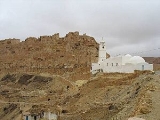
Chenini
Encyclopedia
Chenini is a ruined Berber
village in the Tataouine
district in southern Tunisia
. Located on a hilltop near a modern village of the same name, Chenini was a fortified granary
, or ksar
(plural ksour.) Like other ksour created by North African Berber communities, Chenini was built on a hilltop - in this instance, between two hilltop ridges - to help protect it from raiding parties. The oldest structures on the hillside date back to the 12th century; some of the buildings are still used to store grain for the villagers living in the valley below. Chenini is a regular stop on southern Tunisia's ksar
trail, along with the villages of Douiret
, Ksar Ouled Soltane
and Ksar Hadada
.
Chenini and the surrounding Tataouine
district are also associated with the Star Wars
film series. Many scenes for the movies were filmed in the area; one of the moons of the home planet of Luke Skywalker
was named Chenini.
Berber people
Berbers are the indigenous peoples of North Africa west of the Nile Valley. They are continuously distributed from the Atlantic to the Siwa oasis, in Egypt, and from the Mediterranean to the Niger River. Historically they spoke the Berber language or varieties of it, which together form a branch...
village in the Tataouine
Tataouine
Tataouine , also transliterated as Tatooine, Tatahouine, Tatahouïne, Tatawin, Fum Taţāwīn, Fumm Tattauin, Foum Tatahouine, Fum Tatawin, or Foum Tataouine, from the Berber Tittawin, literally meaning Eyes, with the figurative meaning of Water springs , is a city located in southern Tunisia...
district in southern Tunisia
Tunisia
Tunisia , officially the Tunisian RepublicThe long name of Tunisia in other languages used in the country is: , is the northernmost country in Africa. It is a Maghreb country and is bordered by Algeria to the west, Libya to the southeast, and the Mediterranean Sea to the north and east. Its area...
. Located on a hilltop near a modern village of the same name, Chenini was a fortified granary
Granary
A granary is a storehouse for threshed grain or animal feed. In ancient or primitive granaries, pottery is the most common use of storage in these buildings. Granaries are often built above the ground to keep the stored food away from mice and other animals.-Early origins:From ancient times grain...
, or ksar
Ksar
Ksar is the Arabic term for "castle", loaned from Latin castrum.The Berber equivalent is aghrem or ighrman ....
(plural ksour.) Like other ksour created by North African Berber communities, Chenini was built on a hilltop - in this instance, between two hilltop ridges - to help protect it from raiding parties. The oldest structures on the hillside date back to the 12th century; some of the buildings are still used to store grain for the villagers living in the valley below. Chenini is a regular stop on southern Tunisia's ksar
Ksar
Ksar is the Arabic term for "castle", loaned from Latin castrum.The Berber equivalent is aghrem or ighrman ....
trail, along with the villages of Douiret
Douiret
Douiret is a ruined Berber village in the Tataouine district in southern Tunisia. Located on a hilltop near a modern village of the same name, Douiret was a fortified granary, or ksar Like other ksour created by North African Berber communities, Douiret was built on a hilltop to help protect it...
, Ksar Ouled Soltane
Ksar Ouled Soltane
Ksar Ouled Soltane is a fortified granary, or ksar, located in the Tataouine district in southern Tunisia. The ksar is spread out over two courtyards, each of which has a perimeter of multi-story vaulted granary cellars, or ghorfas...
and Ksar Hadada
Ksar Hadada
Ksar Hadada is a ksar in southeastern Tunisia. Star Wars: The Phantom Menace was filmed here.- External links :*...
.
Chenini and the surrounding Tataouine
Tataouine
Tataouine , also transliterated as Tatooine, Tatahouine, Tatahouïne, Tatawin, Fum Taţāwīn, Fumm Tattauin, Foum Tatahouine, Fum Tatawin, or Foum Tataouine, from the Berber Tittawin, literally meaning Eyes, with the figurative meaning of Water springs , is a city located in southern Tunisia...
district are also associated with the Star Wars
Star Wars
Star Wars is an American epic space opera film series created by George Lucas. The first film in the series was originally released on May 25, 1977, under the title Star Wars, by 20th Century Fox, and became a worldwide pop culture phenomenon, followed by two sequels, released at three-year...
film series. Many scenes for the movies were filmed in the area; one of the moons of the home planet of Luke Skywalker
Luke Skywalker
Luke Skywalker is a fictional character and the main protagonist of the original film trilogy of the Star Wars franchise, where he is portrayed by Mark Hamill. He is introduced in Star Wars Episode IV: A New Hope, in which he is forced to leave home, and finds himself apprenticed to the Jedi master...
was named Chenini.

